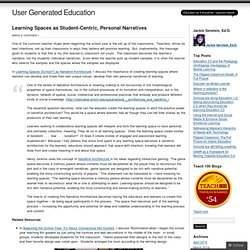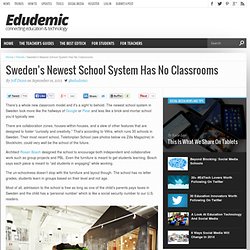

Learning Spaces as Student-Centric, Personal Narratives. One of the common teacher rituals when beginning the school year is the set up of the classrooms.

Teachers, driven by best intentions, set up their classrooms in ways they believe will promote learning. But, inadvertently, the message given to students is that this is my (the teacher’s) classroom not yours. The classroom becomes the teacher’s narrative, not the students’ individual narratives. Even when the teacher puts up student samples, it is often the teacher who selects the samples and the spaces where the samples are displayed. In Learning Spaces (School?) Note: At 4 minutes she discusses how they asked the high school kids to design their cafeteria. 12 Reasons We Need To Reinvent The School Desk. Added by Jeff Dunn on 2012-09-27 Students young and old frequently complain about the quality of the desks and chairs provided on campus, yet it remains one of the more overlooked issues. A pity, because poor ergonomics and comfort can actually lead to poor health, and poor health leads to missed classes and heightened medical expenditures once career time rolls around.
Maybe it’s about time educators, schools, and districts reconsidered their approach towards how they set up classrooms. The positive outcomes might very well prove surprising. Sitting increases the risk of a heart attack : Small children probably don’t suffer from the same risk of heart attacks as their parents, but healthy habits stick better when introduced early. This is a post from our content partners at Online Degrees . Comments are closed. Why A Colorado K-12 School Now Resembles An Internet Café. After opening their new facility Sept. 12, Falcon Virtual Academy ’s faculty immediately started using its fresh mix of modern décor and technology. The virtual academy, authorized by Falcon School District 49 in 2010, is now leveraging instructional technologies in a renovated 21,000 square-foot facility, which triples its previous size, increases its Internet bandwidth and expands its students’ options.
Now located at 6113 Constitution Avenue in Colorado Springs, the multidistrict public school for kindergarten-twelfth grade students resembles an Internet café, where bright overhead lighting and computer workstations illuminate bistro and sofa seating areas. “Google Meets Starbucks” Within the colorfully decorated and sprawling learning space, students are interacting with teachers, who are balancing Apple MacBook Pros, iPads and iPhones .
Students are attending Web-based classes with school iMacs and Windows desktops, or their personal laptop attached to the school’s Wifi. How It Worked. Sweden’s Newest School System Has No Classrooms. There’s a whole new classroom model and it’s a sight to behold.

The newest school system in Sweden look more like the hallways of Google or Pixar and less like a brick-and-mortar school you’d typically see. There are collaboration zones, houses-within-houses, and a slew of other features that are designed to foster “curiosity and creativity.” That’s according to Vittra, which runs 30 schools in Sweden. Their most recent school, Telefonplan School (see photos below via Zilla Magazine) in Stockholm, could very well be the school of the future. Architect Rosan Bosch designed the school to encourage both independent and collaborative work such as group projects and PBL. Finland Rethinks Factory-Style School Buildings. For Back to School, Reimagine Classroom Design. Teaching Strategies Lenny Gonzales By Therese Jilek As the school year begins, most classrooms across the country will mirror traditional class design: rows of desks with passive children sitting quietly listening to a teacher in the front of the class.

But not at Hartland-Lakeside. Across the Hartland-Lakeside school district in Hartland, Wisconsin, teachers have transformed their Industrial Age classrooms into innovative, state-of-the-art learning spaces. The innovative spaces were a product of teachers changing how they taught and viewed student learning. Teachers realized that they needed to do more than rearrange the room; they needed to start over. As teachers transformed their roles into facilitators of learning, they found that standing in front of the classroom or lecturing was no longer prudent. Students and teachers work together throughout the day in many different ways. This change also reflects the increased use of mobile technology to personalize learning. Therese Jilek.